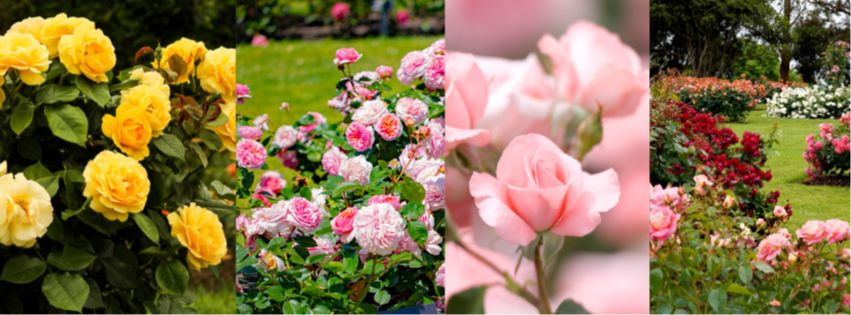How to grow roses
Roses are the queen of the plant world as well as romance, whether they are used as a formal plant in a vast landscape or in a small cottage garden and used for cut flowers.
Roses are abundant in flower and extremely versatile from ground cover to wall plants to hanging baskets, there is a rose in the colour and fragrance that will do all these jobs for everyones particular taste..png)
Before You Get Started
Choosing a Rose
With so many rose varieties to choose from, it can feel overwhelming. To help narrow your options, consider the following:
Flowers
For many, the flowers are the deciding factor when choosing a rose, and it all comes down to personal taste.
Eventual Size
Roses vary in size, from compact varieties ideal for containers to large, vigorous ramblers that can climb through tree branches. Choose a rose that will fit your space.
Planting Position
There are roses to suit nearly every planting site. Consider your garden’s conditions—whether it’s shady, frost-prone, or has soil that dries out in summer—and select a rose that will thrive in those specific conditions.
Buying a Rose
Roses are available in three different forms:
Bare-Root Roses
These plants are dug up from the ground, with the soil removed, and the roots are wrapped to prevent them from drying out. Plant them as soon as possible upon arrival, unless the soil is frozen or waterlogged. In that case, unpack the roses and keep them in a container with damp compost until conditions improve. Compost can be either homemade garden compost or seed/potting compost.
Containerised Roses
These roses are lifted from the ground while dormant, with minimal or no soil around their roots, and are placed in pots of compost to keep them hydrated.
Container-grown roses
These are available all year round and can be planted any time
When to plant Roses
This depends on the type of rose you have bought:
Bare-root roses: Plant out as soon as you receive them, usually in late autumn or from late winter to early spring, while the plant is not actively growing
Containerised roses: Plant all year round, but as soon as possible after buying
Container-grown roses: Plant all year round, as soon as possible after buying
Avoid planting roses when the ground is frozen or waterlogged, or during drought conditions.
Where to plant Roses
To ensure your rose thrives, it's generally best to:
- Plant in a sunny location that receives at least four hours of sunlight per day.
- Avoid areas that are too exposed or windy.
- Provide enough space around the plant—around 60cm (2ft)—to prevent competition for water and light.
Ongoing care
Watering
Roses are deep-rooted plants, so once they have settled in they can usually survive on the moisture naturally present in the soil. However, in hot, dry spells or in dry, sandy soils they may need additional water.
In their first few years after planting, new roses should be watered regularly, especially in summer, until their roots are well established.
How to water roses
When watering, direct the flow onto the soil around the base of the plant, avoiding the foliage and flowers. This helps to deter fungal diseases and avoid excess water use.
Roses in borders
Established roses should really only need watering during dry spells in high summer – when you should water up to once a week, using 5-10 litres (about one large watering can) per plant. If the blooms or leaves start to wilt, then water immediately.
Giving plants a good soak once a week, rather than watering lightly more often, encourages deeper rooting. This makes the plants better able to find moisture in the soil.
Roses in containers
These need much more water than plants growing in the ground. Water as often as needed, which could be daily in hot weather.
Feeding
Roses are nutrient-hungry plants and will thrive with additional feeding and a layer of well-rotted manure for mulching.
How to Feed Roses
Roses in Borders
To encourage abundant blooms, feed your roses twice a year:
In March/April, before flowering begins.
In mid-summer, after the first flush of flowers (especially for repeat-flowering varieties).
Sprinkle a general-purpose or rose fertiliser around the plant, using 70g per square meter (2oz per square yard). Then, apply a mulch of well-rotted manure or garden compost, leaving a gap of 10cm (4in) around the base of the stems.
Roses in Containers
Roses in containers need more frequent feeding than those in borders, as they have limited access to nutrients.
Feed every two weeks from mid-spring to late summer.
Weeding
Keep the soil around your rose free of weeds to ensure healthy growth. Since roses produce some of their roots near the surface, it's best to hand-weed to avoid damaging them, rather than using a hoe. Just be cautious around the thorns! Applying a thick layer of mulch in spring will help prevent annual weeds from germinating.
Deadheading
To promote additional blooms, remove faded flowers once a week or so. If you skip deadheading, many roses will form hips (seed pods) and stop producing new flowers.
Some roses produce especially attractive hips—it's best to refrain from deadheading these varieties in mid-summer to allow the hips to fully form.
Rose hips also serve as an important winter food source for birds like thrushes and blackbirds.
.png)
Pruning and training
The two key aims of pruning are to keep the plant healthy and shape it correctly. This is done by:
- Removing any dead, diseased or damaged shoots
- Opening up the centre of the plant to improve air circulation, which deters fungal diseases
